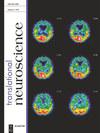Longitudinal PET studies of mGluR5 in FXS using an FMR1 knockout mouse model
IF 1.8
4区 医学
Q4 NEUROSCIENCES
引用次数: 3
Abstract
Abstract Fragile X syndrome (FXS) is a monogenic disorder characterized by intellectual disability and behavioral challenges. It is caused by aberrant methylation of the fragile X mental retardation 1 (FMR1) gene. Given the failure of clinical trials in FXS and growing evidence of a role of metabotropic glutamate subtype 5 receptors (mGluR5) in the pathophysiology of the disorder, we investigated mGluR5 function in FMR1 Knockout (FMR1-KO) mice and age- and sex-matched control mice using longitudinal positron emission tomography (PET) imaging to better understand the disorder. The studies were repeated at four time points to examine age- and disease-induced changes in mGluR5 availability using 3-fluoro-[18F]5-(2-pyridinylethynyl)benzonitrile ([18F]FPEB). We found that the binding potential (BP) of [18F]FPEB was significantly lower in the KO mice in mGluR5-implicated brain areas including striatum, cortex, hippocampus, thalamus, and olfactory bulb. The BP also changed with age, regardless of disorder status, increasing in early adulthood in male but not in female mice before decreasing later in both sexes. The difference in mGluR5 availability between the FMR1-KO and control mice and the change in BP in the KO mice as a function of age and sex illustrate the nature of the disorder and its progression, providing mechanistic insights for treatment design.使用FMR1敲除小鼠模型对FXS中的mGluR5进行纵向PET研究
脆性X综合征(Fragile X syndrome, FXS)是一种以智力障碍和行为障碍为特征的单基因疾病。它是由脆性X智力迟钝1 (FMR1)基因的异常甲基化引起的。鉴于FXS的临床试验失败,以及越来越多的证据表明代谢性谷氨酸亚型5受体(mGluR5)在FMR1敲除(FMR1- ko)小鼠和年龄和性别匹配的对照小鼠中的作用,我们利用纵向正电子发射断层扫描(PET)成像研究了mGluR5在FMR1敲除(FMR1- ko)小鼠和对照组小鼠中的功能,以更好地了解FXS。在四个时间点重复研究,使用3-氟-[18F]5-(2-吡啶乙基)苯腈([18F]FPEB)检查年龄和疾病引起的mGluR5可用性变化。我们发现KO小鼠在与mglur5相关的大脑区域,包括纹状体、皮质、海马、丘脑和嗅球,[18F]FPEB的结合电位(BP)显著降低。血压也随着年龄的增长而变化,与疾病状态无关,雄性小鼠在成年早期升高,而雌性小鼠没有升高,随后雌雄小鼠均下降。FMR1-KO小鼠与对照小鼠之间mGluR5可用性的差异以及KO小鼠血压随年龄和性别的变化说明了疾病的性质及其进展,为治疗设计提供了机制见解。
本文章由计算机程序翻译,如有差异,请以英文原文为准。
求助全文
约1分钟内获得全文
求助全文
来源期刊

Translational Neuroscience
NEUROSCIENCES-
CiteScore
3.00
自引率
4.80%
发文量
45
审稿时长
>12 weeks
期刊介绍:
Translational Neuroscience provides a closer interaction between basic and clinical neuroscientists to expand understanding of brain structure, function and disease, and translate this knowledge into clinical applications and novel therapies of nervous system disorders.
 求助内容:
求助内容: 应助结果提醒方式:
应助结果提醒方式:


